Recent Articles
Popular Makes
Body Types
2021 Hyundai Veloster Road Test and Review
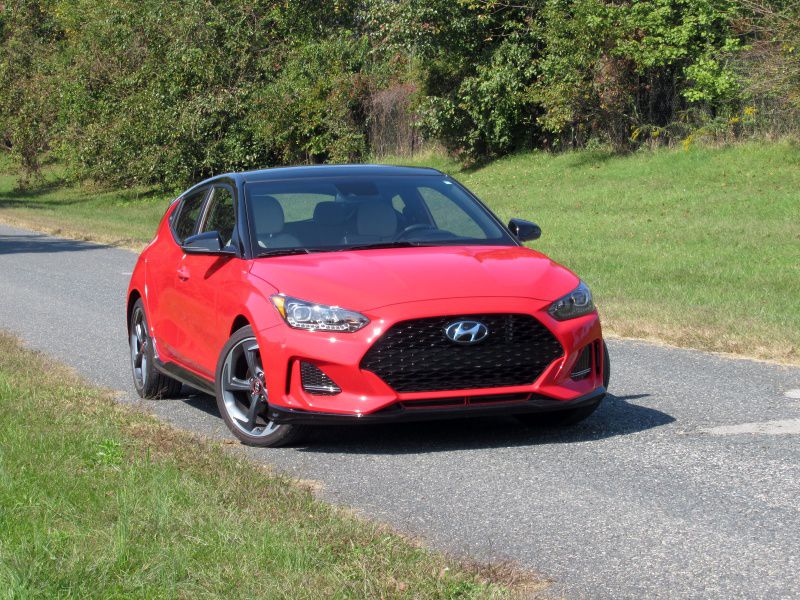
2020 Hyundai Veloster Turbo Ultimate ・ Photo by Brady Holt
Most economy cars follow a straightforward formula. There’s a similar four-door sedan or five-door hatchback shape, with two passenger doors on each side. Many of these cars are functional but forgettable. And even among the ones that look great or offer a higher-grade driving experience, there’s little effort to reimagine this market segment.
By contrast, the 2021 Hyundai Veloster is something unique. Mechanically, it’s mostly the same as the Hyundai Elantra compact sedan. But it wears the pugnacious body of a hot hatchback, looking anything but ordinary. A passenger-side-only rear door and hatchback body style add versatility, and despite the Veloster’s high-style body, it’s still one of the most affordable cars sold in the U.S. today — it starts at just $18,900. Optional turbocharged engines add some spice that matches the Veloster’s sporty looks, while advanced safety technology and excellent crash-test scores protect you in case of imprudent exuberance. Let’s delve more into this combination of style, value, and driving fun.
No Longer So Novel
The first-generation Hyundai Veloster made a splash when it debuted in 2012. It looked like a concept car that had rolled straight out of an auto show and into dealerships. But by the time the second generation arrived as a 2019 model, the novelty had worn off. Hyundai was conservative the second time around, tweaking the original formula rather than continuing to innovate. There was a huge mechanical upgrade — the Veloster is now derived from the larger, more solidly built, and more powerful Elantra rather than the subcompact Hyundai Accent — but people were paying less attention.
The 2021 Veloster is handsome enough, but it’s not really a head-turner. The front end already looks a generation old as Hyundai moves into more dramatic new designs on other models. Some buyers will appreciate a dynamic body with simple lines, but the newly redesigned 2021 Elantra sedan looks cutting-edge in comparison. Around back, the Veloster’s angry-looking taillights and center-mounted exhaust pipes contrast with its sedate front end. Our favorite view is the side profile, where the vehicle hunches forward assertively without being over-the-top.
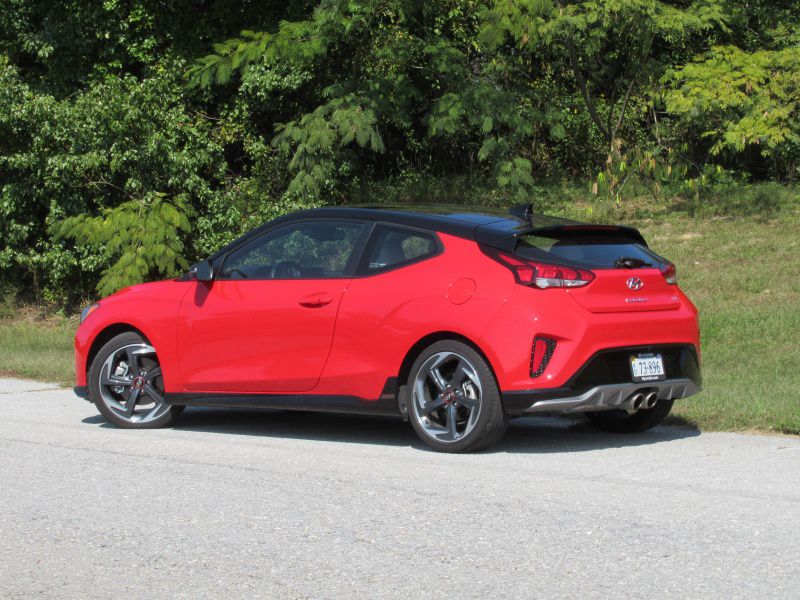
Photo by Brady Holt
Straightforward Interior
The Veloster dresses up its interior with colored accents on the steering wheel, shifter, seats, and instrument panel. It also has the quirk of different-colored trim on the driver door versus the passenger door. Otherwise, for better or for worse, its dashboard would be at home in any economy car from the past few years.
Base Velosters have a 7-inch infotainment touchscreen, while other trims have 8 inches. All perch atop the dashboard, above straightforward buttons and knobs. Everything is easy to use, without distractions, and both infotainment systems support Android Auto and Apple CarPlay smartphone integration. But there’s little flair, and even less luxury. Our top-of-the-line Turbo Ultimate test vehicle brings leather upholstery, but the hard, shiny dashboard plastics are decidedly low-rent. We remember the old Veloster as decidedly creaky inside, and the current model is a step up, but this is still a cheap car that feels cheap inside. We also missed power-adjustable seats on our test car.
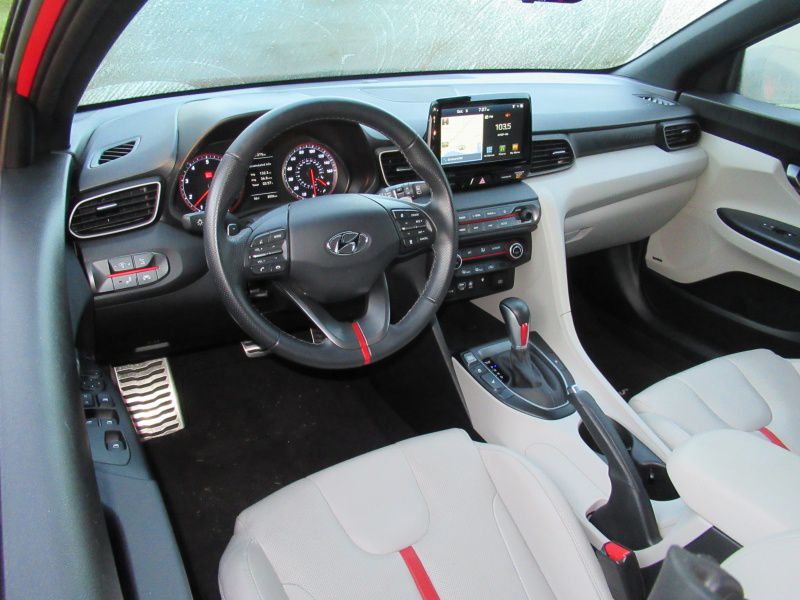
Photo by Brady Holt
Useful Layout
Like the first-generation Veloster, the 2021 model hides a rear door on the passenger side of the vehicle. That means the driver’s side has a longer door for a traditional two-door look and easier driver access, while the passenger side has a smaller front door to make room for a subtle rear door. Its door handle hides up by the window.
This layout means the Veloster looks smaller and tauter than a five-door Honda Civic or Mazda3 hatchback, yet rear passengers don’t have to clamber over the front seats to get in and out. Having the back door also made it much easier for us to install and use a child safety seat. The two-passenger backseat isn’t generously spacious, and to sit on the driver’s side, you have to slide uncomfortably over a plastic console (or enter from the driver’s door like on a coupe). Cargo space is good for a sporty car, due to the hatchback body style: 19.9 cubic feet behind the rear seat, and 44.5 cubic feet with the rear seat folded. A Civic hatchback is much roomier, but the Mazda3 is not.
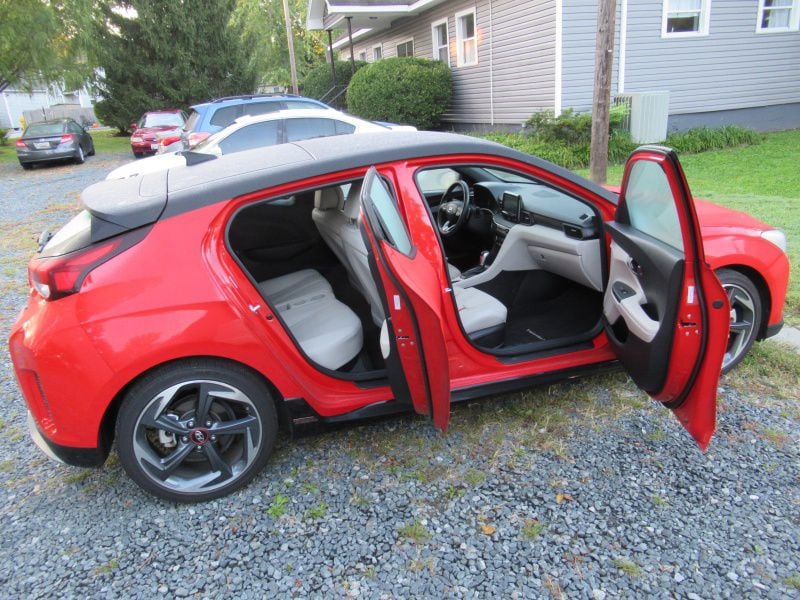
Photo by Brady Holt
Fast but Thrifty
The Veloster comes standard with a 2.0-liter 147-horsepower four-cylinder engine that it shares with the Elantra. This is the engine you pick if you want a sporty-looking small car but don’t want to pay extra for genuine performance. Upper-trim models get a zesty turbocharged 1.6-liter four-cylinder, which makes 201 hp — a lot of zip for a little car like this one. The top Veloster N model has up to 275 hp for downright ferocious acceleration.
A slick-shifting six-speed manual transmission is available with all three engines, though not on every trim level. For automatics, the base 2.0-liter has a six-speed conventional automatic, while the 1.6-liter offers a seven-speed dual-clutch transmission (DCT), and the N is newly available this year with an eight-speed DCT. The base Veloster gets decent EPA ratings of 30 mpg overall with the automatic and 28 mpg with the manual. The more advanced 1.6 turbo still gets 30 mpg with the DCT automatic and 29 mpg with the manual, despite having much more power. Our 1.6-liter DCT test vehicle averaged an outstanding 35 mpg. The Veloster N averages 25 mpg with a manual and just 22 mpg with the automatic.
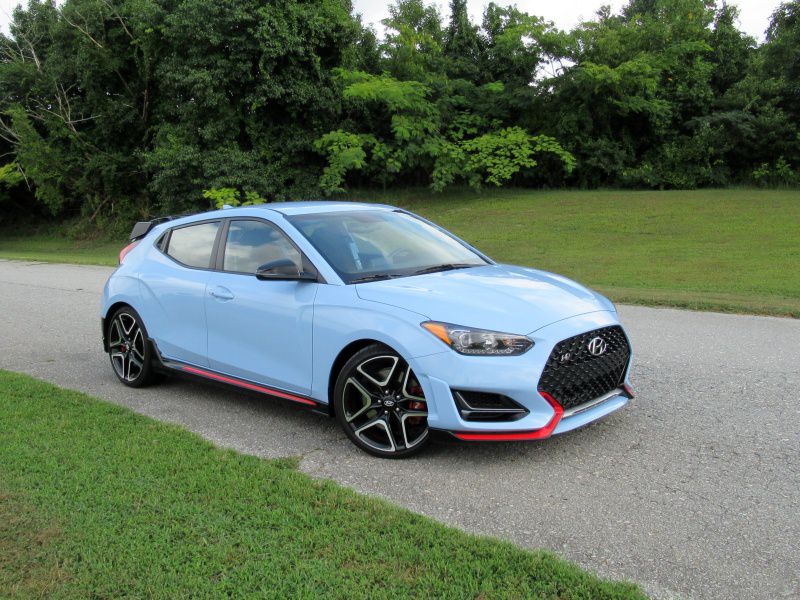
Photo by Brady Holt
Agile and Fun to Drive
The Veloster lives up to its styling with responsive, nicely weighted steering that makes it fun to drive even in everyday driving. That’s actually this Hyundai’s best habitat, in fact, until you step up to the racetrack-ready Veloster N. Our test vehicle could have used more steering feedback when pushed closer to its limits. Still, this is an agile, fun-to-drive little hatchback, and this sharpness is a great complement to the lively turbo engines.
Despite its sharp handling, the Veloster also rides comfortably. The suspension is tuned firmly, but it’s not overly stiff. However, road and engine noise starts to intrude at highway speeds, given that our test vehicle’s engine is geared to run at nearly 2,500 rpm at 70 mph.
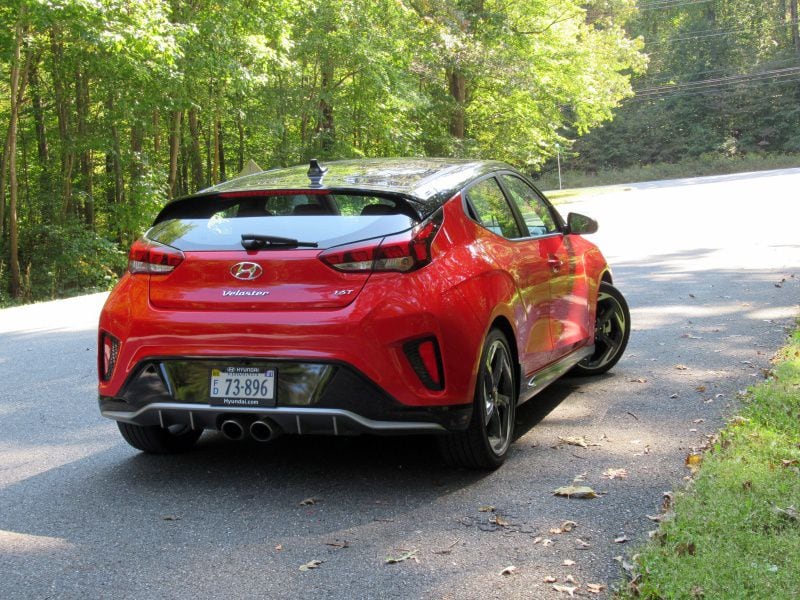
Photo by Brady Holt
Top Safety Pick
The Veloster is a cheap, fun car, but it’s also laden with advanced safety technology as standard equipment. This includes a forward-collision warning with automatic emergency braking, a lane-departure warning with lane-keeping steering corrections, and a driver attention monitor. Most trim levels also include blind-spot monitoring with a rear cross-traffic alert, and the fanciest Turbo Ultimate model adds adaptive cruise control and a more advanced automatic emergency braking system with pedestrian-detection capabilities.
The Veloster earned a Top Safety Pick designation from the Insurance Institute for Highway Safety, reflecting its outstanding performance in a battery of crash tests and its effective collision-avoidance features. It only gets knocked for its headlights, which score Acceptable on high-end Velosters and Poor on base trim levels. The National Highway Traffic Safety Administration hasn’t tested the vehicle.
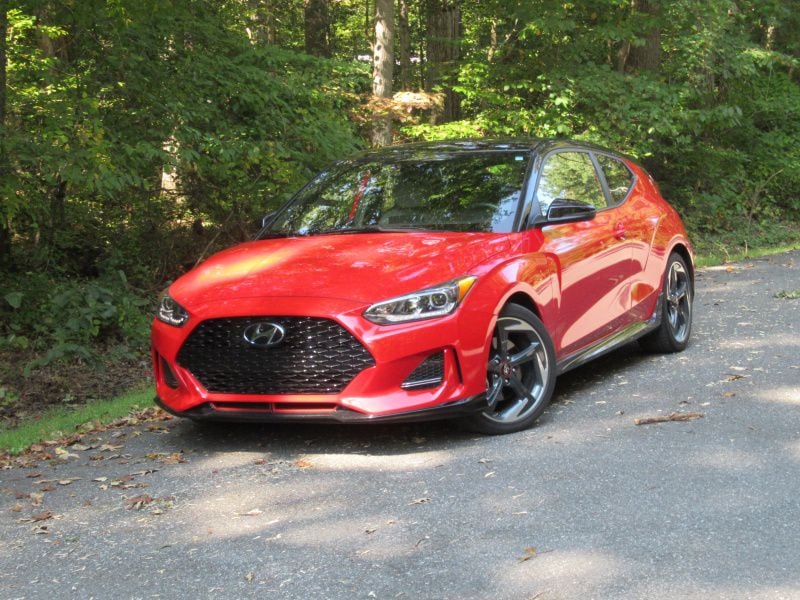
Photo by Brady Holt
Affordable Pricing
The 2021 Veloster starts at $18,900 with a full suite of modern safety and infotainment systems, plus dressy 17-inch alloy wheels, making it less expensive than many humdrum economy sedans. Hyundai sweetens the deal with the same 10-year powertrain warranty and three years of free scheduled maintenance it offers on all models.
The 2.0 Premium model, $23,100, adds an automatic transmission (it’s optional on the base model) blind-spot monitoring, partial-leather upholstery and a leather-wrapped steering wheel, heated front seats, a sunroof, wireless smartphone charging, an Infinity sound system, push-button starting, blind-spot monitoring, and a bigger 8-inch touchscreen. Or, for $23,450, you can give up some of those creature comforts to get the 1.6-liter Turbo R-Spec with a manual transmission and a sport-tuned suspension. The Turbo model, $25,570, brings back the 2.0 Premium’s features while keeping the superior engine. The Turbo Ultimate, like our test vehicle, costs $28,450 and includes leather, a head-up display, rain-sensing windshield wipers, a navigation system, and the most advanced driver aids. The 2020 Veloster N cost $27,600, but 2021 pricing isn’t yet available.
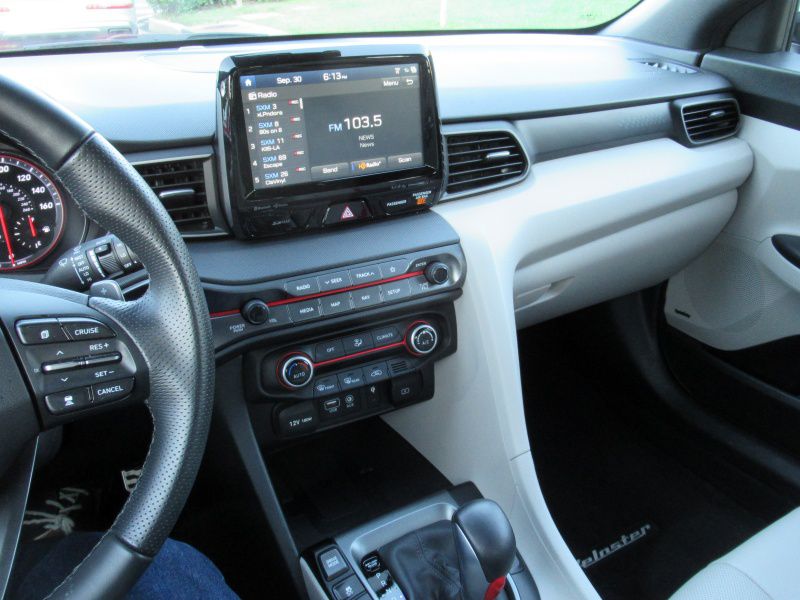
Photo by Brady Holt
Competitors to Consider
The Veloster’s closest competitors are more traditional economy hatchbacks: the Honda Civic and Mazda3. Both are fun to drive and reasonably affordable, but they’re less focused on performance than the Veloster. They have better-finished interiors, particularly the luxury-grade Mazda, and the Civic is much roomier. The Veloster has more user-friendly controls, and neither of them can match its 201-horsepower turbo.
You could also shop the Veloster against less spacious, versatile small sporty cars ranging from the MINI Cooper to the Subaru BRZ and Toyota 86 to the Chevrolet Camaro and Ford Mustang. In this company, the Veloster stands out for its spunky driving fun and fantastic value for the money, if not for its style, perfect steering precision, or interior finishings.
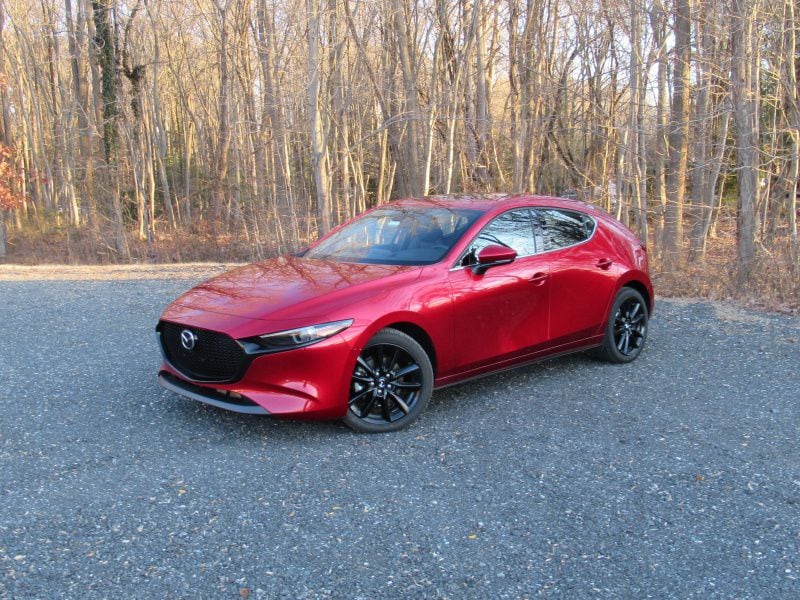
Photo by Brady Holt
Fun on a Budget
Whatever type of fun you’re looking for, you can find it in the 2021 Hyundai Veloster. If “fun” means a car that avoids looking too serious, the 2.0-liter Veloster brings a sporty design without forcing you to sacrifice everyday comfort and usability (or too much of your paycheck). If fun means agile handling and zippy acceleration, the 1.6-liter model is a performance bargain, one of the least expensive vehicles you can get with 200 horsepower or more. And if extra speed is your goal, the Veloster N delivers it even for less than $30,000.
We wish Hyundai could invest some money into updating the Veloster’s style and interior materials. And if you’re shopping it against a more spacious hatchback, you might wish for a fifth seating position and more rear-seat space. But as a performance bargain, the Veloster is already a standout.
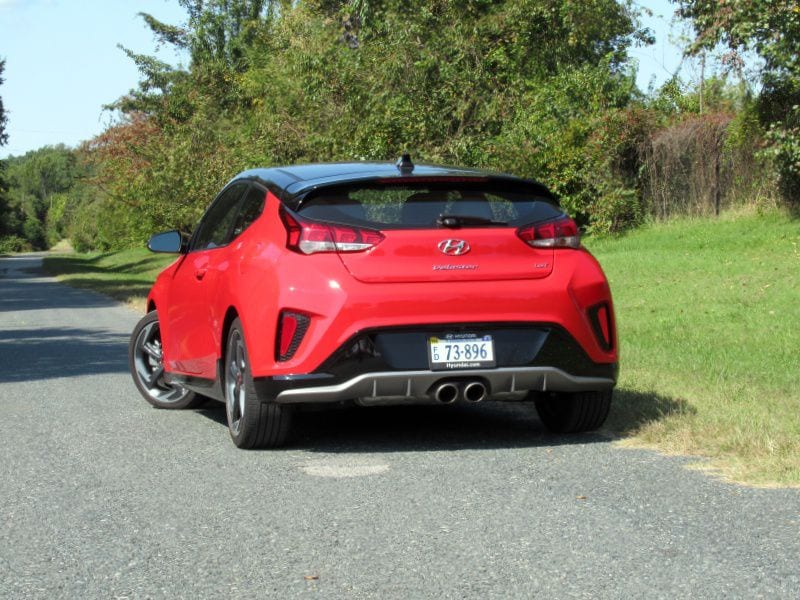
Photo by Brady Holt